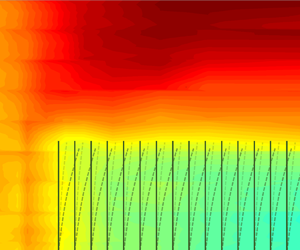No CrossRef data available.
Article contents
A simple prediction of time-mean and wave orbital velocities in submerged canopy
Published online by Cambridge University Press: 29 February 2024
Abstract

Flow within submerged canopies influences the transport of nutrients, sediment, pollutants, plant seeds and the settlement of larvae. To improve our understanding of mass transport within canopies, a simple model is proposed to predict the total time-varying velocity within submerged rigid canopies (representing coral reefs) and flexible canopies (representing seagrasses and saltmarshes). The model divides the momentum equations into a canopy layer and free-stream layer. The difference in the time derivative of the velocity between the two layers is balanced by the sum of the shear stress and canopy drag, both of which depend on the in-canopy total velocity. The present model extended the shear stress model developed for steady current to combined current and wave conditions without additional calibrating coefficients. The model agreed well with the in-canopy velocity measured in the present and several previous studies. Importantly, the proposed model significantly improved the accuracy of canopy time-mean velocity prediction, which reduced the root mean square error by more than 50 %, compared with previous models. The model revealed that the addition of waves can significantly decrease the in-canopy time-mean velocity.
- Type
- JFM Papers
- Information
- Copyright
- © The Author(s), 2024. Published by Cambridge University Press





